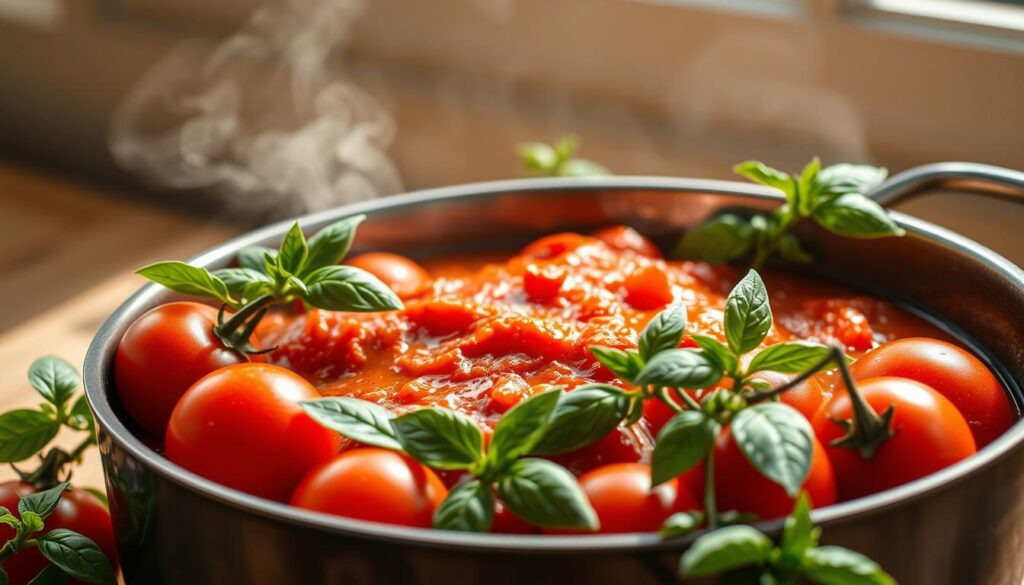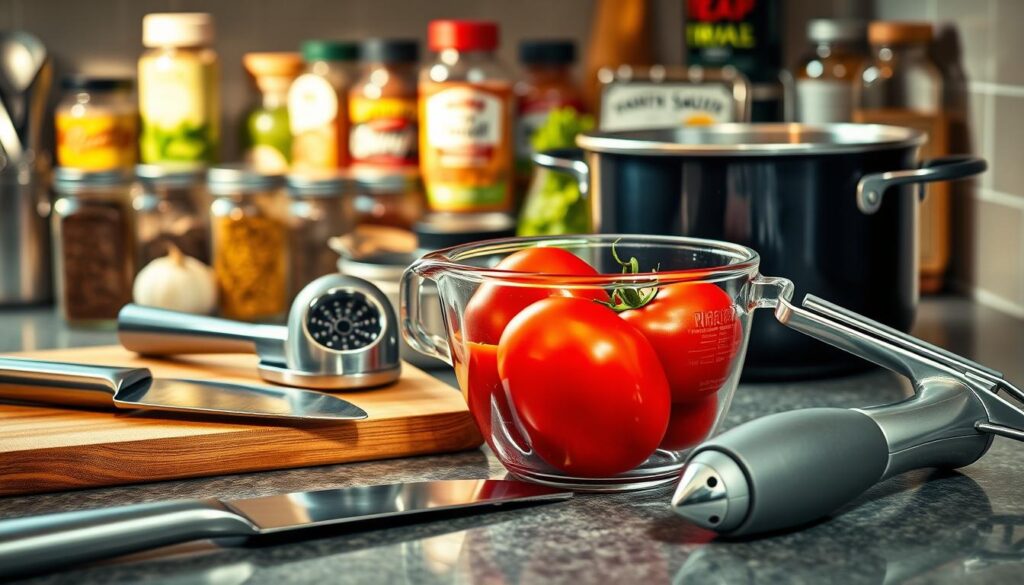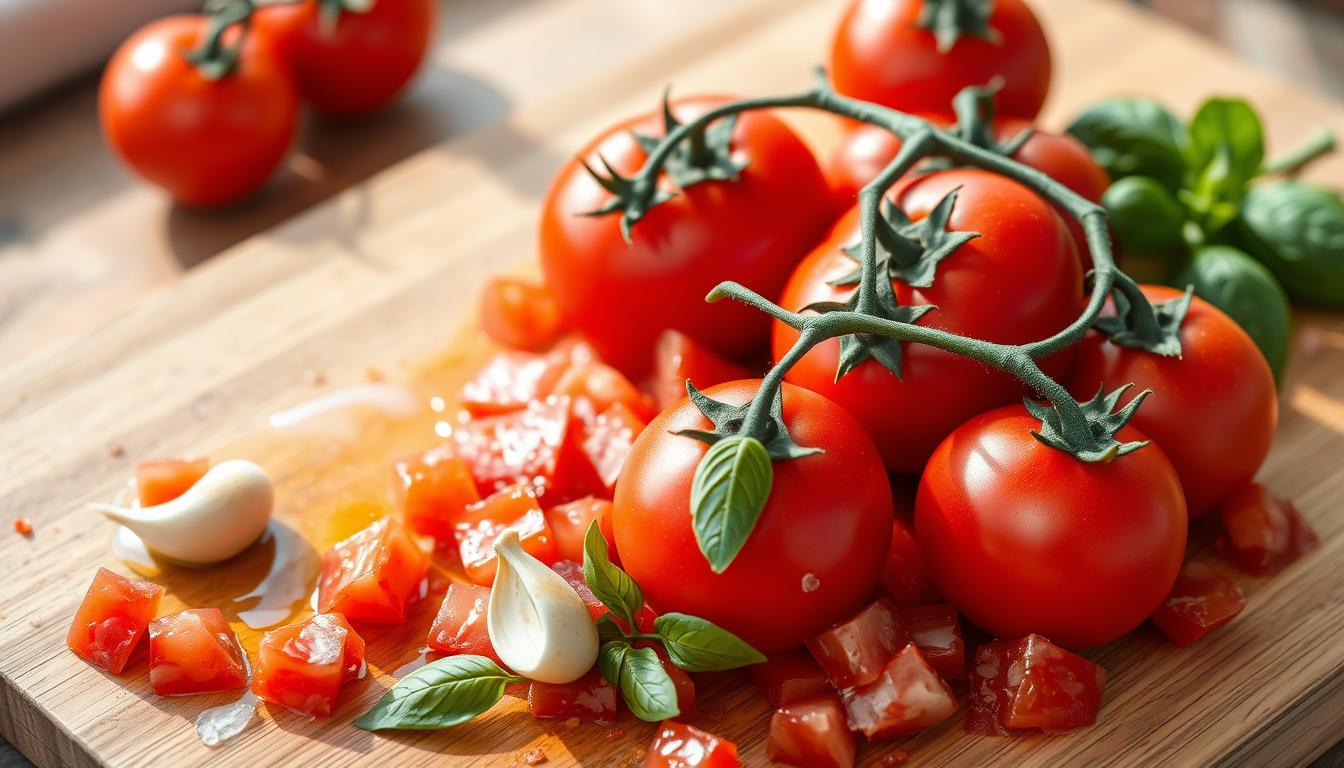Summer’s garden harvest brings a tasty challenge: what to do with all those ripe tomatoes? Making fresh tomato sauce is more than cooking. It’s a celebration of the season and creativity in the kitchen.
Turning your garden’s tomatoes into homemade sauce is a fun ritual. It connects you to where your food comes from. These seven recipes will help you capture summer’s spirit, making simple ingredients into amazing sauces that make every meal better.
Whether you’re an experienced cook or just starting, making fresh tomato sauce is rewarding. It lets you keep summer’s flavors alive, cuts down on food waste, and creates something special that store-bought sauces can’t.
Our collection of homemade tomato sauce recipes will show you how to get deep, rich flavors. You’ll learn about classic Italian marinara and new vegetable-packed sauces. Discover how a perfect sauce can be versatile and delicious.
Get ready to change your cooking with these seven fresh tomato sauce recipes. They will become key parts of your cooking routine.
Classic Italian Marinara: The Foundation of Homemade Sauces
Making an authentic organic tomato sauce is a skill passed down through generations. The classic marinara is the base of many Italian dishes. It adds rich flavors and traditional cooking methods to your kitchen.
Essential Ingredients for Authentic Flavor
An easy tomato sauce recipe begins with top-quality ingredients. The marinara’s taste depends on the right parts:
- Ripe Roma or San Marzano tomatoes
- Extra virgin olive oil
- Fresh garlic and onions
- Fragrant herbs like basil and oregano
- High-quality sea salt
Step-by-Step Preparation Guide
Making the perfect marinara needs patience and focus. Start by blanching tomatoes to remove the skins. Then, crush them for a smooth sauce base.
| Ingredient | Quantity | Preparation |
|---|---|---|
| Tomatoes | 5 pounds | Blanched and crushed |
| Olive Oil | 1/4 cup | Heated in pan |
| Garlic | 4 cloves | Minced finely |
Traditional Seasoning Techniques
The secret to a great organic tomato sauce is in the herbs and spices. Slowly simmer your sauce to blend flavors. This creates a depth that store-bought sauces can’t match.
“A great marinara is like a symphony of flavors, each ingredient playing its perfect note.” – Italian Cooking Wisdom
Your homemade marinara will turn simple meals into amazing dishes. It brings the taste of Italy to your dinner table.
Roasted Garlic and Fresh Tomato Sauce
Making tomato sauce from scratch gets even better with roasting. Roasting turns simple ingredients into deep, rich flavors. This makes your tomato sauce go from good to great.
Roasting brings out the sweetness in tomatoes and garlic. This creates a rich base for your sauce. The caramelization of sugars adds depth and complexity.
Roasting Techniques for Perfect Flavor
- Select ripe, fresh tomatoes for the best results
- Halve tomatoes and drizzle with extra virgin olive oil
- Roast at 350°F for 20-30 minutes until edges caramelize
- Wrap whole garlic heads in foil before roasting
Your roasted garlic tomato sauce will make pasta nights special. It’s easy to do but packs a big punch of flavor.
| Ingredient | Roasting Temperature | Roasting Time |
|---|---|---|
| Tomatoes | 350°F | 20-30 minutes |
| Garlic | 400°F | 30-40 minutes |
Pro tip: Blend your roasted tomatoes and garlic for a silky smooth sauce. It will wow any home cook.
Spicy Arrabbiata: Adding Heat to Your Sauce
Discover the fiery side of your pasta sauce with an authentic Arrabbiata recipe. This sauce adds a bold kick to your meals. It makes simple pasta dishes into unforgettable ones.
Arrabbiata sauce, or “angry” in Italian, brings a passionate heat to your pasta. The secret is in choosing and balancing your spicy ingredients well.
Balancing Spice Levels
Getting the perfect heat is all about balance. You want to add layers of flavor without being too much. Here’s how to do it:
- Use fresh red pepper flakes for the best taste
- Begin with a little heat and add more as needed
- Think about how spicy your guests like things
Ingredient Proportions for Perfect Heat
For the perfect spicy sauce, you need to get the mix right. Here’s a good starting point:
| Ingredient | Quantity |
|---|---|
| Paste Tomatoes | 10 lbs |
| Red Pepper Flakes | 2-3 tablespoons |
| Olive Oil | 1/4 cup |
Proper Storage Methods
To keep your sauce’s flavors strong, follow these storage tips:
- Use clean glass jars
- Heat them in boiling water to sterilize
- Keep them in a cool, dark spot
- Put them in the fridge once opened
Follow these steps, and your spicy Arrabbiata sauce will make every pasta meal special.
Garden Vegetable Tomato Sauce
Turn your fresh tomato sauce into a nutrient-rich dish by adding garden veggies. Organic tomato sauce gets a boost when mixed with the flavors of homegrown produce.
Making a garden vegetable tomato sauce is a great way to add flavor and nutrition. Choose vegetables that complement the tomatoes without overpowering them.
- Bell peppers add sweet complexity
- Zucchini provides moisture and subtle texture
- Carrots contribute natural sweetness
- Onions enhance depth of flavor
When making your tomato sauce, chop veggies finely so they blend well. Sauté them first to bring out their flavors before adding tomatoes.
| Vegetable | Nutritional Benefit | Preparation Tip |
|---|---|---|
| Bell Peppers | Vitamin C, Antioxidants | Dice finely, sauté until soft |
| Zucchini | Fiber, Low Calories | Grate or finely chop |
| Carrots | Beta-carotene, Vitamin A | Microplane or small dice |
For the best taste, use organic vegetables from your garden or a local farmer’s market. This way, your organic tomato sauce is full of fresh, healthy ingredients that make your dishes better.
Fire-Roasted Tomato Sauce: Smoky Flavors
Making a rich, smoky tomato sauce needs special roasting methods. These methods turn simple ingredients into a culinary masterpiece. Fire-roasting adds depth and complexity, making your sauce go from good to great.
Roasting Techniques for Maximum Flavor
To get the perfect smoky taste, try different roasting ways. The goal is to get a nice char that adds flavor without burning the tomatoes.
- Oven roasting at 375°F for 30 minutes
- Grilling tomatoes directly over open flame
- Using a cast-iron skillet for controlled charring
Equipment and Temperature Control
The right tools are key for fire-roasted tomato sauce. A good grill, cast-iron skillet, or baking sheet helps control temperature. This ensures consistent results.
Seasoning and Storage Tips
After roasting, add herbs and spices to boost flavor. Smoked paprika, fresh basil, and garlic enhance the smokiness. Store your sauce in vacuum-sealed bags or airtight containers to keep its flavor.
“The secret to an unforgettable tomato sauce is in the roasting technique.” – Chef’s Wisdom
Sweet Basil and Fresh Tomato Sauce

Making a delicious tomato sauce with sweet basil changes how you cook. Cherry and grape tomatoes are perfect for a simple sauce that’s sweet. They add a lot of flavor to your dishes.
Choosing the right tomatoes is key to a great sauce. Mix sweet tomatoes with paste tomatoes like Roma for the best texture. You want a sauce that’s full of fresh, vibrant flavors.
- Select ripe cherry or grape tomatoes for maximum sweetness
- Choose fresh basil leaves for aromatic depth
- Mix sweet tomatoes with paste varieties for ideal consistency
Basil adds a unique herbal flavor to your sauce. Add fresh basil leaves at the end to keep their flavor bright. Gently tear the leaves to release their oils and make your sauce smell amazing.
Pro tip: The secret to a truly delicious tomato sauce is using the freshest ingredients and treating them with care.
When making your sauce, cook it gently to keep the tomatoes sweet. Cooking slowly lets the flavors grow, making a sauce that will wow anyone.
Preserving Methods for Homemade Sauces
Making a tasty homemade tomato sauce is just the start. Knowing how to keep it fresh is key. Whether it’s a classic marinara or a spicy arrabbiata, the right methods will keep it delicious for months.
There are many ways to keep your sauce fresh. Each method has its own benefits for flavor and shelf life.
Water Bath Canning Process
Water bath canning is great for acidic sauces like tomato sauce. Here’s what you need to do:
- Use sterilized glass jars
- Add 1 tablespoon of lemon juice per pint to ensure proper acidity
- Process pint jars for 35 minutes
- Process quart jars for 45 minutes
Freezer Storage Options
Freezing is a simple way to store tomato sauce. Here are some tips:
- Use freezer-safe containers with tight-fitting lids
- Leave 1 inch of space at the top for expansion
- Label containers with date and sauce type
- Freeze for up to 3-4 months
Vacuum Sealing Techniques
Vacuum sealing is another way to preserve your sauce. It removes air, which helps keep it fresh longer.
| Preservation Method | Shelf Life | Difficulty Level |
|---|---|---|
| Water Bath Canning | 12-18 months | Moderate |
| Freezer Storage | 3-4 months | Easy |
| Vacuum Sealing | 6-12 months | Advanced |
Pick the method that suits your skills and storage space. Each way has its own benefits for enjoying your sauce for a long time.
Essential Equipment and Safety Guidelines

To make an easy tomato sauce, you need the right tools and safety tips. Start your fresh tomato sauce journey with the proper equipment for tasty and safe results.
Here are the must-have kitchen tools for making fresh tomato sauce:
- Large stainless steel pot
- Food mill or fine-mesh strainer
- Sharp chef’s knife
- Cutting board
- Canning jars with lids
- Jar lifter
- Funnel
When you’re making and preserving your homemade sauce, safety is key. Follow these important steps to avoid foodborne illnesses:
- Always wash your hands before cooking
- Sterilize canning jars in boiling water for 10 minutes
- Use clean, undamaged equipment
- Check jar seals after cooling
- Store preserved sauce in cool, dark places
When making your fresh tomato sauce, cleanliness is paramount. Clean equipment stops bacterial growth. This keeps your sauce safe and tasty for months.
Pro tip: Invest in quality canning tools to make your sauce preparation safer and more efficient.
Remember, making an easy tomato sauce needs patience and focus. By using the right equipment and safety tips, you’ll make sauce as good as a restaurant’s in your own kitchen.
Best Tomato Varieties for Sauce Making
Creating the perfect organic tomato sauce starts with picking the right tomatoes. Not all tomatoes are the same when it comes to sauce. The flavor, texture, and quality of your sauce depend on the tomatoes you choose.
Both professional chefs and home cooks agree on the best tomatoes for sauce. It’s all about finding the right flavor and texture.
Paste Tomatoes vs. Regular Varieties
Paste tomatoes are the top choice for sauce-making. They have special traits that make them perfect for rich, concentrated sauces:
- Meaty texture with fewer seeds
- Lower water content
- More intense flavor profile
Top Tomato Varieties for Sauce
| Variety | Characteristics | Best Used For |
|---|---|---|
| Roma | Firm flesh, minimal seeds | Classic marinara sauce |
| San Marzano | Sweet flavor, low acidity | Gourmet organic tomato sauce |
| Amish Paste | Large, meaty tomatoes | Thick, rich pasta sauces |
Ripeness and Selection Criteria
When picking tomatoes for your sauce, look for these signs of quality:
- Deep, vibrant color
- Firm but slightly soft to touch
- Strong, sweet tomato aroma
- No blemishes or soft spots
“The secret to an amazing sauce is always in the quality of your tomatoes.” – Chef Mario Batali
Seasonal Considerations
Tomatoes are at their best from July to September. This is when you’ll find the most flavorful, ripe tomatoes for sauce. If fresh tomatoes are not available, high-quality canned San Marzano tomatoes are a great substitute.
Conclusion
Making delicious tomato sauce at home turns your kitchen into a fun place. We’ve shown you seven ways to make tasty sauces that make any meal better. You can go from a classic marinara to fire-roasted sauces, making your kitchen a place of endless possibilities.
Learning how to keep your sauces fresh is important. You can use water bath canning, freezer storage, or vacuum sealing to keep them good for months. Each recipe lets you try new flavors and make healthier sauces than store-bought ones.
But your tomato sauce journey doesn’t stop here. Try different tomatoes, roasting methods, and spices. Making your own sauce means you can always change it to fit your taste and what you have on hand. Soon, you’ll have a sauce that’s special to your family.
Creating homemade tomato sauce is more than just cooking. It’s about connecting with your food, saving money, and enjoying fresh tastes. Start making your own sauce today and see how simple ingredients can become amazing dishes.

